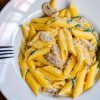BLOG
When eating fruit and vegetables hurt?

How many times have you been told that consuming lots of fruit and vegetables is a good habit? But what are the actual quantities? The general suggestions indicate the canonic 5/6 portions a day, but this is not enough to define a healthy diet. After all, as you know very well, in a truly balanced diet the benefits are also conditioned by the quantities. Eating fruit and vegetables is good, but what side effects can be related to excessive consumption?
According to the opinion of the nutritionist and scientific communicator Derry Procaccini, generic indications without specifications on quality and quantity, only help to increase the confusion and the risk of problems related to obesity. In this article, we will talk about fructose, one of the elements most present in fruit to deepen the issue of consumption in terms of quality and quantity. At the end of this reading, you will be able to understand how the fruit interacts with our organism and, consequently, get the maximum benefits from a balanced consumption.
First of all, it is good to know that the fruit should be divided into at least two categories:
- Oily dried fruit: rich in good fats, minerals and low in sugars such as almonds, cashews, pine nuts, peanuts, and walnuts;
- Sugary fruit: low in good fats and rich in simple sugars such as dates, mangoes, grapes, apples, pears, peaches, plums, apricots, bananas etc.
In the first case, considering the relationship between good fats and sugar poverty, these are not particularly dangerous foods for the increase in insulin and therefore they can be eaten with less caution. The sugary fruit instead, contains about 50% fructose and 50% of glucose. In this case, the presence of two simple sugars, called monosaccharides, would require us to limit their consumption. This is because the two types of elements are ingested also through other sources during the day. But how do these two elements work with our body?
What are glucose and fructose?
Glucose is a sugar (aldehyde monosaccharide) whose concentration in the blood is called glycemia. Blood glucose levels depend on glucose uptake through food, glycogen storage, and hormone regulation. Glucose is the most naturally occurring sugar and is very important because it is used by both animals and plants as the main energy source. The most important property of glucose is its reduced reaction to the amino groups of proteins that gives life to glycation. The latter reduces or completely cancels the activity of many enzymes and is responsible for many long-term effects of diabetes such as blindness or poor renal function.
Fructose (also known as levulose) belongs to the family of so-called simple sugars and is found in many sugary fruits, honey, and some vegetables. Many of you know that fructose is a particular sugar, mainly because it is metabolized in the body through specific pathways that differ from those of glucose. But what effects can the fruit trigger at the metabolic level, after a meal already rich in carbohydrates and high glycemic index?
Fructose: how it works in our body
Fructose metabolism typically generates uric acid within minutes of ingestion. Uric acid is a waste product found in the blood and high levels of this element are normally associated with gout. This relationship has long been recognized, especially for overweight people, who suffer from high blood pressure and kidney disease. What is striking, however, is that the functions of uric acid in cells are classified both as an antioxidant and as a pro-oxidant. Therefore, if the uric acid is reduced too much, its antioxidant benefits are lost, while with too high levels there is a tendency to increase its role as a pro-oxidant.
According to the research, the ideal levels of uric acid are found between 3 – 5.5 mg/dl. Previously, uric acid was thought to be secondary in stimulating disorders and pathologies, but researchers have identified a central role of this element. When uric acid levels reach or exceed 5.5 mg/dl the risk is to develop hypertension, as well as diabetes, obesity and other kidney disorders.
.
Fructose and glycemic index
Until recently, it seemed that the only monosaccharide (simple sugar) we had to watch out for was glucose. However, more and more studies show that fructose with its direct effect on the glycemic rise is one of the most dangerous sugars. As a result, we tried to define a recommended maximum daily intake.
To clarify the issue and give you the tools to know the contribution of sugars to your body, in the table below, we roughly estimated the quantities of glucose and fructose of the main fruits.
| Food | Total glucose (gr / kg of food) | Total fructose (gr / kg of food) |
| Fruit | ||
| Oranges | 29-39 | 31-33 |
| Banana | 42-62 | 41-62 |
| Strawberries | 25 | 20-27 |
| Mandarins | 10-11 | 18-38 |
| Apple | 29-32 | 80 |
| Pear | 12.5-16 | 60 |
| Lemon Juice | 8-9 | 9 |
| Verdura e ortaggi | ||
| Garlic | 14 | 8 |
| Carrots | 23.5 | 23 |
| Lettuce | 2.4-5.1 | 3.1 |
| Eggplant | 13-16 | 12-16 |
| Pepperoni | 15-25 | 13-16 |
| Peas | 2.3-19 | 2.25-10 |
| Fresch Tomatoes | 13-14 | 15-19 |
| Zucchini | 9.5-11 | 8-12 |
We must not forget that the intake of sugars stimulates the production of natural opioids, a key factor in addiction. The brain becomes essentially dependent on opioids not unlike morphine or heroin addiction. The more you eat it, the more you need it, creating a vicious circle in consumption.
Dr. Richard Johnson, a professor of medicine at the University of Colorado and director of the kidney division who is also involved in transplantation and blood pressure research, has conducted extensive research into fructose and its effects. In his books: The Fix Sugar and The Fat Switch meticulously described the dangers of fructose.
He focused on the study of the effects of this element on the metabolic system both at the level of cell cultures and in animals and through clinical studies. In his research he has investigated the relationship between fructose and obesity, high blood pressure, kidney disease, hypertension, fatty liver and other health problems. The results led him to identify the effects that uric acid has on blood pressure, insulin production and renal function.
The Professor has indeed shown that 90% of obese adolescents with newly diagnosed hypertension had high levels of uric acid. The cure for normalizing blood pressure in 87% of these adolescents would be achieved simply by lowering uric acid levels.
Another personality that made the difference in this field is Dr. Robert Lustig, Professor of Pediatrics of the Division of Endocrinology at the University of California at San Francisco. The professor tells about his findings on the dangers of fructose and other sugars in a conference that you can find online and we recommend you take a look. (This is the link to the video: https://www.youtube.com/watch?v=dBnniua6-oM )
How to take fructose
Since 55% of the recommended daily fructose quota is in a can of sweet drink, pay attention to the doses introduced with the fruit. As we anticipated at the beginning of this article we commonly think we can eat fruit at will, but we must remember that fruit, especially the best, and therefore sweeter, is rich in fructose and glucose.
As a standard recommendation, our nutritionist Derry Procaccini strongly recommends that you maintain total fructose consumption fewer than 25 grams per day. However, for most people, it would also be wiser to limit fruit fructose to 15 grams or less, as it is practically guaranteed that hidden sources are consumed through most beverages and through almost all processed foods.
Fructose and Agave
Another consideration must then be made on Agave’s syrup. This food is often described as a valid alternative to common sugar (sucrose). According to research by another specialist; Dr. Ingrid Kohlstadt, a colleague of the American College of Nutrition and associate professor at the Johns Hopkins School of Public Health; however, the sap is chemically processed by the agave plant producing a compound known as high fructose hydrolyzate or inulin syrup. This alternative to common sugar (sucrose) has nothing to do with the original Agave plant and has no nutritional value.
Here, we do not want to discredit the nutritional value of fruit but to pay attention to the possible side effects of excessive consumption and to spread information on specific, sometimes very different, characteristics among fruit varieties. To conclude, we leave a table in which we reported the relationship between fruit, recommended dose size, and grams of fructose content.
| FRUIT | Dose | Grams of fructose |
| Limes | 1 | 0 |
| Lemon | 1 | 0.6 |
| Blueberries | 1 cup | 0.7 |
| Passion fruit | 1 | 0.9 |
| Apricot | 1 | 1.3 |
| Guava | 2 | 2.2 |
| Dates | 1 | 2.6 |
| Cantaloupe | 1/8 of half melon | 2.8 |
| Raspberries | 1 cup | 3.0 |
| Clementines | 1 | 3.4 |
| Kiwi | 1 | 3.4 |
| Blackberries | 1 cup | 3.5 |
| Cherries | 10 | 3.8 |
| Strawberries | 1 cup | 3.8 |
| Cherries, sour | 1 cup | 4.0 |
| Ananas | 1 slice (3,5 “x 0,75″) |
4.0 |
| Grapefruit | 1/2 | 4.3 |
| Mandarins | 1 | 4.8 |
| Nectarine | 1 | 5.4 |
| Peach | 1 | 5.9 |
| Orange | 1 | 6.1 |
| Papaya | 1/2 | 6.3 |
| Honeydew | 1 | 6.7 |
| Banana | 1 | 7.1 |
| Apple | 1 | 9.5 |
| Khaki | 1 | 10.6 |
| Watermelon | 1/16 | 11.3 |
| Pear | 1 | 11.8 |
| Raisin | 1/4 of a cup | 12.3 |
| Grapes | 1 cup | 12.4 |
| Mango | 1/2 | 16.2 |
| Dried Apricots | 1 cup | 16.4 |
| Dried figs | 1 cup | 23.0 |




